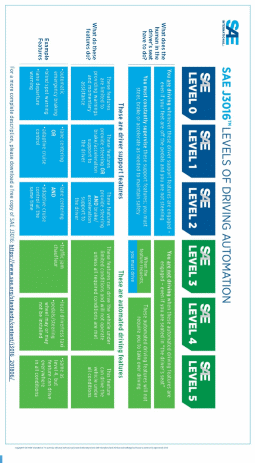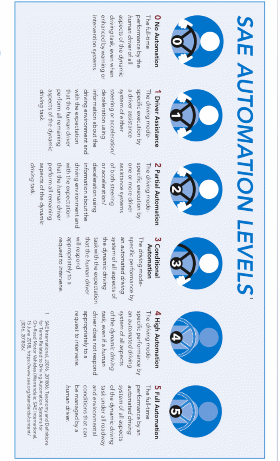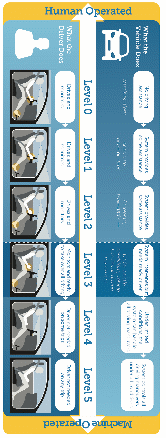NHTSA Form 1531 ADS Consumer Education Research FG Workbook
Generic Clearance for the Collection of Qualitative Feedback on Agency Service Delivery
ADS Consumer Education Research FG - WORKBOOK - 2019.11.12
Qualitative Feedback on How to Communicate More Effectively with Consumers about Automated Driving Systems
OMB: 2127-0682
OMB Control No. 2127-0682
Expiration Date 08/31/2021
Levels of Automation
WORKBOOK
Version 11.12
NAME: _________________________________________
LOCATION: _____________________________________
TIME: __________________________________________
DATE: _________________________________________
This collection of information is voluntary and will be used for formative purposes only so that we may develop communications programs designed to reduce the number of traffic-related injuries and deaths. A federal agency may not conduct or sponsor, and a person is not required to respond to, nor shall a person be subject to a penalty for failure to comply with a collection of information subject to the requirements of the Paperwork Reduction Act unless that collection of information displays a current valid OMB Control Number. The OMB Control Number for this information collection is 2127-0682. Public reporting for this collection of information is estimated to be approximately 4 minutes per response, including the time for reviewing instructions, completing and reviewing the collection of information. All responses to this collection of information are voluntary. Send comments regarding this burden estimate or any other aspect of this collection of information, including suggestions for reducing this burden to: Information Collection Clearance Officer, National Highway Traffic Safety Administration, 1200 New Jersey Ave, S.E., Washington, DC, 20590
ACTIVITY #1
Please carefully read the description below.
WB1. Which of these two perspectives comes closest to your own?
Place a check mark next to the one you most agree with.
|
Some people say that it’s safer when the human driver is in complete control of all the vehicle functions. They trust themselves more than technology, and say that technology software could be hacked, or that they can’t fully relax in a vehicle where the computer assists with certain driving tasks. |
|
Others say that vehicles in which drivers are assisted by a computer are safer. Technology can react more quickly and reliably than people can, technology can be rigorously tested in a wide range of situations before they are allowed on vehicles, and new and better technology is on the horizon. |
---STOP!---
DESCRIPTION #1
Please carefully read the description below.
Advanced driver assistance systems in today’s motor vehicles are already helping to save lives and prevent injuries.
A number of today’s new motor vehicles have technology that helps drivers avoid drifting into adjacent lanes or making unsafe lane changes, or that warns drivers of other vehicles behind them when they are backing up, or that brakes automatically if a vehicle ahead of them stops or slows suddenly, among other things. These and other technologies use a combination of hardware (sensors, cameras, and radar) and software to help vehicles identify certain safety risks so they can warn the driver to act to avoid a crash. They are the precursor and building blocks to more futuristic technological vehicle safety advancements.
The continuing evolution of automotive technology aims to deliver even greater safety benefits and – one day – deliver automated driving systems that can handle the whole task of driving when we don’t want to or can’t do it ourselves.
---STOP!---
DESCRIPTION #2
Please carefully read the description of the different levels of automation on this page.
-
Level 0
You are driving and have access to driver support features that are limited to warnings and momentary assistance (vehicle offers blind spot warning, lane departure warning and/or emergency braking).
Level 1
You are driving and have access to driver support features that provide steering OR brake acceleration to support the driver (vehicle offers lane centering, adaptive cruise control but they work independently).
Level 2
You are driving and have access to driver support features that provide steering AND brake acceleration to support the driver (vehicle offers lane centering and adaptive cruise control at the same time).
Level 3
You are NOT driving when the automated driving features are engaged – even if you are seated in the driver’s seat. These features can drive the vehicle under limited conditions and will not operate unless all required conditions are met. Additionally, when the feature requests, you must drive.
Level 4
You are NOT driving when the automated driving features are engaged – even if you are seated in the driver’s seat. These features can drive the vehicle under limited conditions and will not operate unless all required conditions are met. You are not required to take over driving.
Level 5
You are NOT driving when the automated driving features are engaged – even if you are seated in the driver’s seat. These features can drive the vehicle under all conditions.
---STOP!---
ACTIVITY #2.1: Progression from Level 0 – 1
Please answer the questions on this page at the moderator’s instruction.
LEVELS:
-
Level 0
You are driving and have access to driver support features that are limited to warnings and momentary assistance (vehicle offers blind spot warning, lane departure warning and/or emergency braking).
Level 1
You are driving and have access to driver support features that provide steering OR brake acceleration to support the driver (vehicle offers lane centering, adaptive cruise control but they work independently).
How comfortable would you be moving from driving a Level 0 vehicle to Level 1 vehicle? Please circle one.
1 2 3 4 5 6 7 8 9 10
Not at all
comfortable
Extremely comfortable
---STOP!---
ACTIVITY #2.2: Progression from Level 1 – 2
Please answer the questions on this page at the moderator’s instruction.
LEVELS:
-
Level 1
You are driving and have access to driver support features that provide steering OR brake acceleration to support the driver (vehicle offers lane centering, adaptive cruise control but they work independently).
Level 2
You are driving and have access to driver support features that provide steering AND brake acceleration to support the driver (vehicle offers lane centering and adaptive cruise control at the same time).
How comfortable would you be moving from driving a Level 1 vehicle to Level 2 vehicle? Please circle one.
1 2 3 4 5 6 7 8 9 10
Not at all
comfortable
Extremely comfortable
---STOP!---
ACTIVITY #2.3: Progression from Level 2 – 3
Please answer the questions on this page at the moderator’s instruction.
LEVELS:
-
Level 2
You are driving and have access to driver support features that provide steering AND brake acceleration to support the driver (vehicle offers lane centering and adaptive cruise control at the same time).
Level 3
You are NOT driving when the automated driving features are engaged – even if you are seated in the driver’s seat. These features can drive the vehicle under limited conditions and will not operate unless all required conditions are met. Additionally, when the feature requests, you must drive.
How comfortable would you be moving from driving a Level 2 vehicle to Level 3 vehicle? Please circle one.
1 2 3 4 5 6 7 8 9 10
Not at all
comfortable
Extremely comfortable
---STOP!---
ACTIVITY #2.4: Progression from Level 3 – 4
Please answer the questions on this page at the moderator’s instruction.
LEVELS:
-
Level 3
You are NOT driving when the automated driving features are engaged – even if you are seated in the driver’s seat. These features can drive the vehicle under limited conditions and will not operate unless all required conditions are met. Additionally, when the feature requests, you must drive.
Level 4
You are NOT driving when the automated driving features are engaged – even if you are seated in the driver’s seat. These features can drive the vehicle under limited conditions and will not operate unless all required conditions are met. You are not required to take over driving.
How comfortable would you be moving from driving a Level 2 vehicle to Level 3 vehicle? Please circle one.
1 2 3 4 5 6 7 8 9 10
Not at all Extremely
comfortable comfortable
---STOP!---
ACTIVITY #2.5: Progression from Level 4 – 5
Please answer the questions on this page at the moderator’s instruction.
LEVELS:
-
Level 4
You are NOT driving when the automated driving features are engaged – even if you are seated in the driver’s seat. These features can drive the vehicle under limited conditions and will not operate unless all required conditions are met. You are not required to take over driving.
Level 5
You are NOT driving when the automated driving features are engaged – even if you are seated in the driver’s seat. These features can drive the vehicle under all conditions.
How comfortable would you be moving from driving a Level 4 vehicle to Level 5 vehicle? Please circle one.
1 2 3 4 5 6 7 8 9 10
Not at all Extremely
comfortable comfortable
---STOP!---
ACTIVITY #3
Please carefully read the description of levels of automation on this page. For each level, think about features and technologies along with any keywords or phrases that should be used in defining that level and making it clear how it is different from other levels.
LEVEL |
DESCRIPTION |
DEFINING FEATURE & TECHNOLOGY AND KEYWORDS & PHRASES |
What would you you call it? |
Level 0 |
You are driving and have access to driver support features that are limited to warnings and momentary assistance (vehicle offers blind spot warning, lane departure warning and/or emergency braking). |
|
|
Level 1 |
You are driving and have access to driver support features that provide steering OR brake acceleration to support the driver (vehicle offers lane centering, adaptive cruise control but they work independently). |
|
|
Level 2 |
You are driving and have access to driver support features that provide steering AND brake acceleration to support the driver (vehicle offers lane centering and adaptive cruise control at the same time). |
|
|
Level 3 |
You are NOT driving when the automated driving features are engaged – even if you are seated in the driver’s seat. These features can drive the vehicle under limited conditions and will not operate unless all required conditions are met. Additionally, when the feature requests, you must drive. |
|
|
Level 4 |
You are NOT driving when the automated driving features are engaged – even if you are seated in the driver’s seat. These features can drive the vehicle under limited conditions and will not operate unless all required conditions are met. You are not required to take over driving. |
|
|
Level 5 |
You are NOT driving when the automated driving features are engaged – even if you are seated in the driver’s seat. These features can drive the vehicle under all conditions. |
|
|
---STOP!---
DESCRIPTION #3
Please take a moment and read through the table of names and descriptions. As you read through the names and descriptions, I want you to think about how well the name fits with the description and if there is anything need to make it a better fit.
-
NAME
DESCRIPTION
No Automation
You are driving and have access to driver support features that are limited to warnings and momentary assistance (vehicle offers blind spot warning, lane departure warning and/or emergency braking).
Driver Assistance
You are driving and have access to driver support features that provide steering OR brake acceleration to support the driver (vehicle offers lane centering, adaptive cruise control but they work independently).
Partial Automation
You are driving and have access to driver support features that provide steering AND brake acceleration to support the driver (vehicle offers lane centering and adaptive cruise control at the same time).
Conditional Automation
You are NOT driving when the automated driving features are engaged – even if you are seated in the driver’s seat. These features can drive the vehicle under limited conditions and will not operate unless all required conditions are met. Additionally, when the feature requests, you must drive.
High Automation
You are NOT driving when the automated driving features are engaged – even if you are seated in the driver’s seat. These features can drive the vehicle under limited conditions and will not operate unless all required conditions are met. You are not required to take over driving.
Full Automation
You are NOT driving when the automated driving features are engaged – even if you are seated in the driver’s seat. These features can drive the vehicle under all conditions.
DESCRIPTION #4

DESCRIPTION #5

DESCRIPTION #6

ACTIVITY #4
When thinking about the different levels of automation, do you tend to…
Circle one
A) think about your vehicle overall operating at a certain level or
B) think about the different types of advanced driver assistance systems equipped in your vehicle that allow it to operate at a certain level?
Why do you say that?
---STOP!---
ACTIVITY #5
Please read carefully and answer the question on this page.
Thinking back about everything we discussed this evening, please turn to the last page in your workbook and indicate which of these two perspectives is closest to your own:
[HUMANS ARE SAFER] Some people say that it’s safer when the human driver is in complete control of all the vehicle functions. They trust themselves more than technology, and say that technology software could be hacked, or that they can’t fully relax in a vehicle where the computer assists with certain driving tasks.
[TECHNOLOGY IS SAFER] Others say that vehicles in which drivers are assisted by a computer are safer. Technology can react more quickly and reliably than people can, technology can be rigorously tested in a wide range of situations before they are allowed on vehicles, and new and better technology is on the horizon.
Please circle one.
DEFINITELY FEEL HUMANS ARE SAFER
SOMEWHAT FEEL HUMANS ARE SAFER
SOMEWHAT FEEL TECHNOLOGY IS SAFER
DEFINITELY FEEL TECHNOLOGY IS SAFER
---STOP!---
NHTSA Form 1531
| File Type | application/vnd.openxmlformats-officedocument.wordprocessingml.document |
| Author | GRETCHEN COMEY |
| File Modified | 0000-00-00 |
| File Created | 2021-01-15 |
© 2025 OMB.report | Privacy Policy